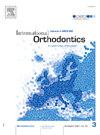社交媒体上正颌手术信息的质量:范围审查。
IF 1.8
Q2 DENTISTRY, ORAL SURGERY & MEDICINE
引用次数: 0
摘要
简介:正颌手术结合正畸治疗通常用于解决面部和牙齿不和谐。上传到社交媒体平台上的内容可能是医疗保健信息的重要来源。本综述旨在整理和综合调查通过这些平台传播的信息质量的研究数据。方法:检索5个数据库和灰色文献,不受发表地点和年份的限制。采用PCC(人口、概念、背景)框架来选择符合条件的研究。纳入标准包括在社交媒体背景下评估正畸手术与正畸治疗相关信息质量的文献。结果:共有12项横断面研究符合选择标准。被调查最多的社交媒体平台是YouTube。调查发现,所有平台上的信息质量都较差至中等。最受欢迎的内容是患者分享他们的治疗经验,但这些内容往往缺乏临床相关信息,主要关注对治疗、结果和监督医疗保健专业人员的满意度。相比之下,医疗保健专业人员提供的内容包含更高质量的信息,但浏览量和参与度较低。最不常被提及的话题是并发症及其持续时间、费用和术后预期。某些搜索词,如“#颌骨手术”、“#手术优先”和“#genioplasty”似乎更能引起公众的共鸣。所使用的信息工具的方法和质量存在异质性。结论:通过社交媒体平台传播的关于正颌手术的信息质量较差至中等。正畸专业人员应该意识到这些在线平台上健康信息的局限性,并引导个人获得更准确的信息来源。本文章由计算机程序翻译,如有差异,请以英文原文为准。
The quality of orthognathic surgery information on social media: A scoping review
Introduction
Orthognathic surgery combined with orthodontic treatment is commonly undertaken to address facial and dental disharmony. Content uploaded onto social media platforms can be an important source of healthcare information. This scoping review aimed to collate and synthesize data from studies that investigated the quality of information communicated through these platforms.
Methods
Five databases and grey literature were searched, with no restrictions on location and year published. The PCC (Population, Concept, Context) framework was adopted to select eligible studies. Inclusion criteria included literature that assessed the quality of information on orthognathic surgery in relation to orthodontic treatment in the context of social media.
Results
A total of 12 cross-sectional studies satisfied the selection criteria. The most investigated social media platform was YouTube. The quality of information on all platforms examined was found to be poor to moderate. The most popular content featured patients sharing their treatment experiences, but these often lacked clinically relevant information, focusing mainly on satisfaction with treatment, outcomes and their supervising healthcare professionals. In contrast, healthcare professionals provided content that contained better quality information but had lower views and engagement. The least frequently mentioned topics were found to be complications and their duration, costs, and postoperative expectations. Certain search terms such as “#jawsurgery”, “#surgeryfirst” and “#genioplasty” appeared to resonate more with the public. There was heterogeneity across the methodologies and quality of information instruments used.
Conclusions
Information communicated through social media platforms regarding orthognathic surgery was of poor to moderate quality. Orthodontic professionals should be aware of the limitations of health information on these online platforms and guide individuals to more accurate sources.
求助全文
通过发布文献求助,成功后即可免费获取论文全文。
去求助
来源期刊

International Orthodontics
DENTISTRY, ORAL SURGERY & MEDICINE-
CiteScore
2.50
自引率
13.30%
发文量
71
审稿时长
26 days
期刊介绍:
Une revue de référence dans le domaine de orthodontie et des disciplines frontières Your reference in dentofacial orthopedics International Orthodontics adresse aux orthodontistes, aux dentistes, aux stomatologistes, aux chirurgiens maxillo-faciaux et aux plasticiens de la face, ainsi quà leurs assistant(e)s. International Orthodontics is addressed to orthodontists, dentists, stomatologists, maxillofacial surgeons and facial plastic surgeons, as well as their assistants.
 求助内容:
求助内容: 应助结果提醒方式:
应助结果提醒方式:


